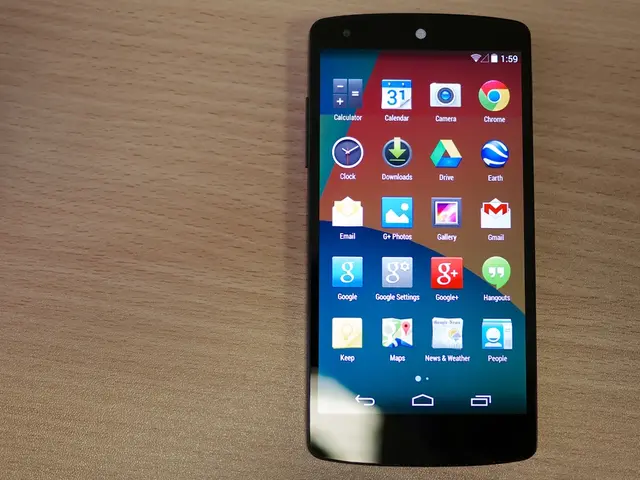Comparing the Amazon Fire TV Stick 4K Max (2nd Gen) and Google TV Streamer: which one is the better purchase?
Streaming Showdown: Fire TV Stick 4K Max vs Google TV Streamer
Ready to elevate your TV's streaming game? Let's chat about the Amazon Fire TV Stick 4K Max (2nd Generation) and Google TV Streamer. These exceptional devices promise an immersive viewing experience, but which one takes the crown? We've got the scoop, so let's dive in!
Design: A Battle of Styles
Amazon's Fire TV Stick 4K Max opts for the petite dongle approach, fitting snugly into your HDMI slot, leaving a minimal footprint. To fully enter the world of stealth mode, be sure to note that this clever gadget might block adjacent HDMI sockets (an included adapter helps to resolve this issue) [1].
On the other hand, Google's little streaming pebble, the TV Streamer, is nicely designed to sit on your media unit. Its porcelain white finish and organic curves create a sleek aesthetic. Google provides an Ethernet port for wired connections, making troubleshooting a breeze! [1]
Both devices offer remote controls, but Google's remote packs an impressive "Find my remote" feature that Amazon saves for its pricier Remote Pro model. [1]
Features: For the Tech-savvy
Amazon has given the Fire TV Stick 4K Max an upgrade, doubling its storage to 16GB and keeping 2GB of RAM. A swift 2.0GHz quad-core processor powers it, while Wi-Fi 6E support and up to 7.1 surround sound are tidily included. [1]
Google, with a bit of extra sparkle, provides 32GB of storage, 4GB of RAM, and claims a more robust processor than the previous model. The optional USB-C port enables peripherals like external storage. Bluetooth 5.1 and Quick Media Switching for smooth transitions between content are also here to save the day. [1]
Both deliver 4K HDR at 60fps, including Dolby Vision, HDR10, and HDR10+. Unfortunately, neither supports DTX:X. [1]
Google's secret weapon? AI integration via its Gemini platform. You'll receive show summaries, season breakdowns, and AI-generated art for your screensaver. Fancy, right? Eh, kind of. It sometimes overshoots, classifying shows that are anything but gritty or bleak. And, a bit more vexing, the interface often has glitches that lead to screen freezing, even with all that added processing power. [2]
Amazon's Fire OS is more straightforward, eschewing AI bells and whistles. However, it has a somewhat ad-heavy interface that boasts Amazon's own services. [1][2]
Picture: HDR Wars
Does the Google TV Streamer's price justify its picture prowess? We found that the Fire TV Stick 4K Max 2nd Gen delivers a superior picture. Its sharp, captivating images burst with astounding detail in clothing textures and skin tones. And, motion handling excels, ensuring smooth scenes without stubborn stuttering. [2]
Google's offering provides enhanced contrast, increased depth, and deeper blacks that augment the overall impact. Colors harmoniously balance excitement and authenticity. Motion processing matches Amazon's competent performance, yet it can seem overbearing and distracting when reproducing film grain. [2]
Sound: Speakers on the Battlefield
You'd expect a more distinct audio upgrade from Google's model due to the price difference. However, the Fire TV Stick 4K Max proved to be the more musical of the two. It presents audacious, cohesive, and dynamic sound, with clear vocals that weave magic into the overall audio landscape. Admittedly, timing isn't its strongest suit, particularly during musical settings. [2]
Google's TV Streamer cannot indulge in vocal joy as it lacks warmth and micro-detail. Voices appear flat and uninviting, sacrificing emotional depth during musical playback. [2]
Choosing the Victor
The Fire TV Stick 4K Max (2nd Generation) delivers nearly identical picture performance to the Google TV Streamer, yet its audio shines brightly and costs less. While Google's AI features and extra storage might appeal, the premium doesn't seem justified when the core performance is so similar. [2]
So, unless you're an ardent Google devotee or need its AI features to make up your mind, the Fire TV Stick 4K Max waltzes triumphantly into your living room. For the rest of us, it's a solid pick! [2]
Further Reading
- Click here for our comprehensive Google TV Streamer review
- Peek at the Amazon Fire TV Stick 4K Max (2nd Generation) review
- Pondering an upgrade from the Chromecast with Google TV? Check out our article, "Google TV Streamer vs Chromecast with Google TV: Should You Upgrade?"
- Find the best media streamers available now
- In the ongoing debate between the Fire TV Stick 4K Max and Google TV Streamer, we delve into their differences in terms of news and technology, providing a review for those looking to buy a hi-fi streaming gadget.
- Design-wise, the Fire TV Stick 4K Max takes the petite dongle approach, while Google TV Streamer sports a sleek, porcelain white finish, each offering unique features in entertainment and general-news contexts.
- Moving onto the tech specs, the Fire TV Stick 4K Max features a quad-core processor, 16GB storage, and Wi-Fi 6E support, while Google TV Streamer offers a more robust processor, 32GB storage, and Bluetooth 5.1.
- Both devices manage 4K HDR at 60fps and support Dolby Vision, HDR10, and HDR10+, but neither device supports DTX:X. Google TV Streamer integrates AI via its Gemini platform, offering added features such as AI-generated art, show summaries, and season breakdowns.
- The Fire TV Stick 4K Max delivers a superior picture with sharp, captivating images and astounding detail, while the Google TV Streamer offers increased contrast, deeper blacks, and harmonious color balance.
- In terms of audio, the Fire TV Stick 4K Max presents a more musical and dynamic sound experience, although its timing isn't its strongest suit during musical settings. Meanwhile, Google TV Streamer struggles to match the same vocal clarity and warmth.







